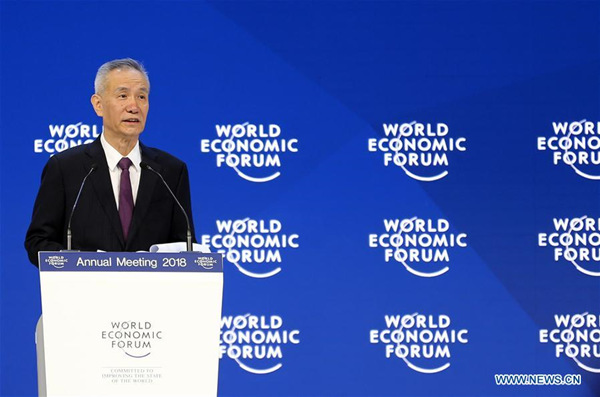 Liu He, a member of the Political Bureau of the Communist Party of China (CPC) Central Committee and director of the General Office of the Central Leading Group for Financial and Economic Affairs, gives a speech during the Annual Meeting 2018 of the World Economic Forum (WEF) in Davos, Switzerland, on Jan. 24, 2018. (Xinhua/Luo Huanhuan) Opening up. Opportunity. Development. These were the three signals sent out Wednesday by China's top representative at the World Economic Forum (WEF) annual meeting in Davos, Switzerland, to the political and business leaders attending the global gathering. Liu He, member of the Political Bureau of the Communist Party of China (CPC) Central Committee, elaborated the path of China's economic development in the coming years and China's pledge to join hands with the rest of the world to create a brighter future for all. CHINA TO OPEN UP FURTHER Liu, who is also director of the General Office of the Central Leading Group for Financial and Economic Affairs, said China will encourage both inbound and outbound investment and business activities as it seeks greater economic and trade interactions with other countries and will work with them to establish an open world economy. China will continue to let the market play a decisive role in resources allocation, and focus on better protection of property rights, especially intellectual property rights, he said. Beijing will further integrate with international trade rules and ease market access. It will substantially open up the services and financial sectors and create a more attractive investment environment. Liu underscored the message that had been presented by Chinese President Xi Jinping in his report at the 19th National Congress of the CPC in October: that China will not close its door to the rest of the world but become more and more open. "That's great!" said Rupert Adams, a partner of Alignvest UK LLP, an investment company. Adams called it a message from China on its continuous reform and opening up, and also a real practical action showing firm support to economic globalization. OPPORTUNITIES, CONTRIBUTIONS TO GLOBAL DEVELOPMENT Liu said after decades of development, a large middle-income population has emerged in China, the biggest in the world, giving rise to a vast domestic market. This open market with a fast-growing population of 400 million will contribute significantly to global development. China's domestic demand has steadily expanded, with consumption contributing 58.8 percent to economic growth, nearly 4 percentage points higher than five years ago, Liu said. The added value of the services sector takes up 60 percent of China's gross domestic product, more than 5 percentage points higher than five years ago. With more rural migrant workers relocating to cities, the number of permanent urban residents has increased by over 80 million in the past five years, accounting for 58.52 percent of the total population, nearly 6 percentage points higher than five years ago. However, China's development faces three challenges, Liu said -- risk prevention, poverty reduction and pollution control. Regarding risk prevention, he said in about three years, China will strive to bring the overall leverage ratio under effective control and make the financial system more adaptable and with better ability to serve the real economy. Systemic risks will be prevented and the flow of economic activities improved. As for poverty reduction, China has a target to eliminate absolute poverty in three years. In the next three years, China will also scale up pollution control to substantially cut major pollutant emissions and lower the intensity of resource consumption. The efforts will improve the environment and make China's development more eco-friendly. These are the concrete actions China will take to fulfill its pledge to counter climate change impacts and implement the Paris Agreement, Liu said. Besides, he pointed out that the Belt and Road Initiative, originating from China, is a concept that will deliver opportunities and benefits to the whole world. Proposed in 2013, the initiative comprises the Silk Road Economic Belt and the 21st-Century Maritime Silk Road, aimed at building a trade and infrastructure network connecting Asia with Europe and Africa along and beyond the ancient Silk Road trade routes. China has inked agreements with more than 80 countries and organizations to jointly develop the initiative. It has also invested more than 50 billion U.S. dollars in key projects under the initiative, thereby creating nearly 200,000 jobs. "It's a very positive message from China," said Mohammed Sharaf, an economy and trade official from the United Arab Emirates. "China's opening up not only benefits itself, but also brings a huge opportunity to the whole world." |
Powered by Discuz! X3.4
© 2001-2013 Comsenz Inc.